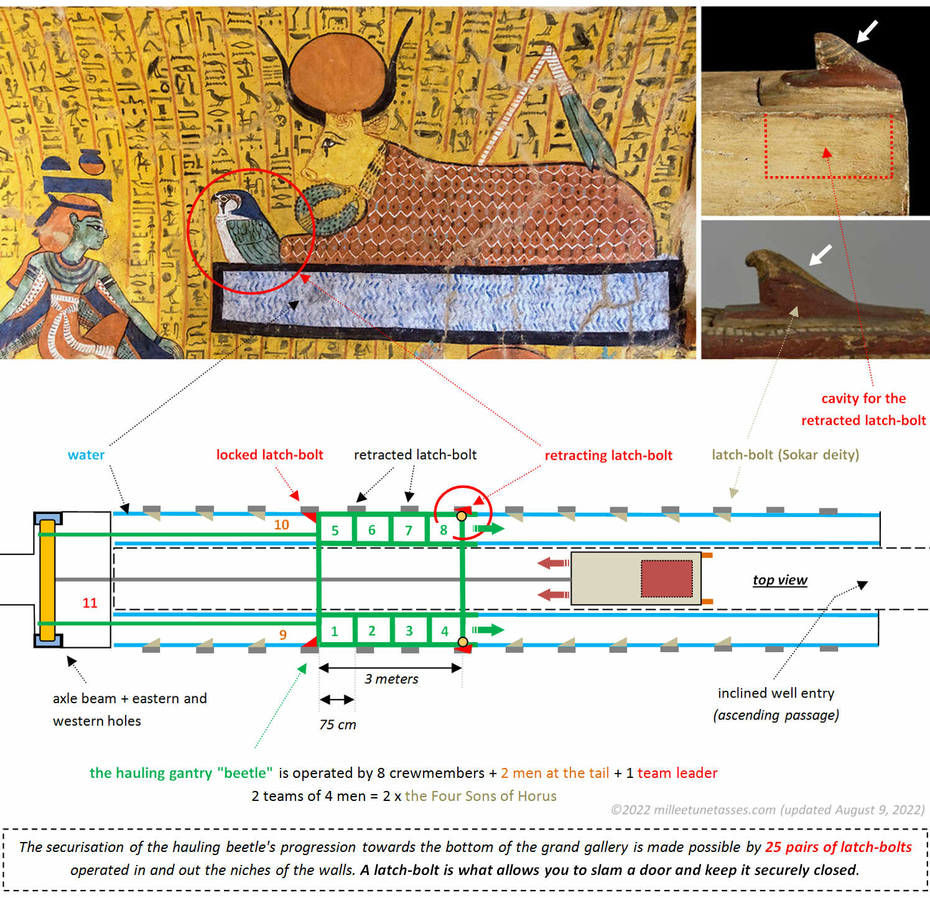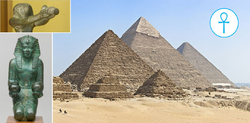- Retour accueil
- Vous êtes ici : Blog The Pyramids of the Cold The Pyramids of the Cold Section 20 • The Weighing of the Heart Myth and the Peeing Baboon
The Pyramids of the Cold Section 20 • The Weighing of the Heart Myth and the Peeing Baboon
Publié par Bruno Coursol dans The Pyramids of the Cold le 09/08/2022 à 17:22
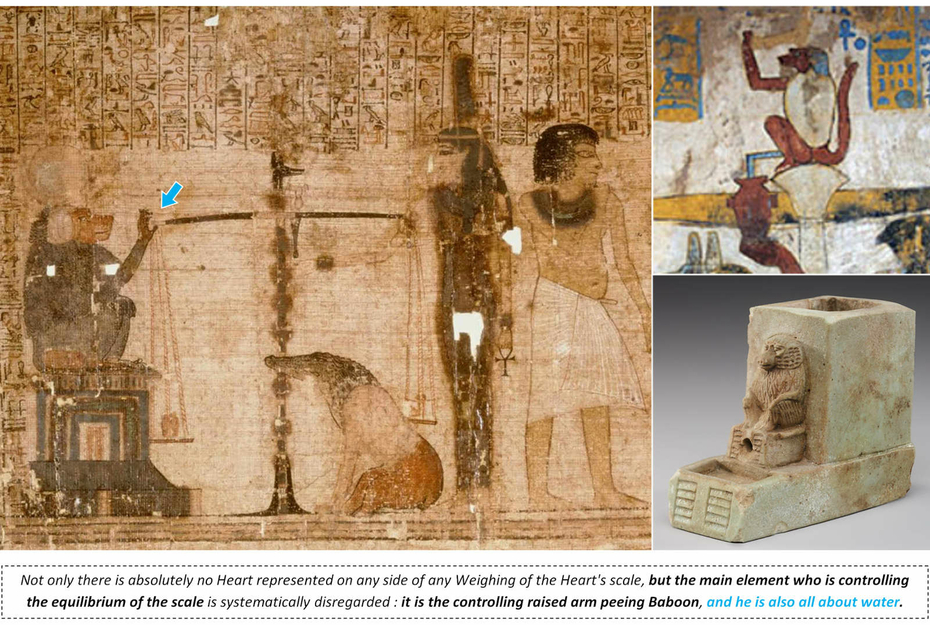
The Weighing of the Heart judgement ritual of the deceased is led by god Anubis into the presence of Osiris, and there makes a Negative Confession, or more correctly a Declaration of Guiltlessness, described in the Spell 125 of the Book of the Dead. Interestingly, there is not such a thing as an act of weighing a heart described anywhere in any spell of any version of the ancient Egyptian Book of the Dead. Everything about the Weighing of the Heart is pure interpretation, even if there is no heart on any scale.
The illustration on the left represents the Weighing of the Heart ceremony in the Book of the dead of Kenna, showing that this is the raised arm peeing baboon who is the one controlling the equilibrium of the scale. Papyrus in the Rijksmuseum van Oudheden in Leiden, Netherlands. Google Art Project : https://artsandculture.google.com/asset/book-of-the-dead-of-kenna-unknown/egEHQ9VZUYIVAg
Image on the right : "ancient Egyptian clepsydra or water clock with squatting baboon. Water within could drain from a hole between the baboon's legs over a measured time".
The Pyramids of the Cold Section 20 • The Weighing of the Heart myth and the peeing Baboon
In summary : the so called Weighing of the Heart scenes are not about weighing any heart, there is no heart on any of the scales. Instead, there are jars filled with water, as suggested by the 'peeing' baboon that nobody is ever talking about, but who is clearly the one controlling the equilibrium of the scale with his raised arm in Kenna's Judgement.
Not only there is no heart on any side of any Weighing of the Heart scale, but the idea itself of weighing a heart on a scale and compare it to a feather or anything else doesn't even appear anywhere in any ancient Egyptian text : the Weighing of the Heart is nothing less but a cute fantasy construction of the 1800's Romanticism influenced egyptology.
The 'Weighing of the Heart' scenes are the continuation of the Geb, Shu and Nut scenes : they are both about liquid water transforming itself into evaporated water.
• the Geb, Shu and Nut scenes are about the endless water cycle between the liquid form (Geb) and the evaporated form (Nut, the water in the sky) that was supported by dry warm air (Shu).
• the 'Weighing of the Heart' scenes are about the efficiency of the process, depending on the humidity rate of the air that was starting the process (the baboon peeing in the small 'equilibrium weight' jar.
In other words, the 'Weighing of the Heart' is about the quantitative aspect of the water evaporation process, while the Geb, Shu and Nut scene is about the qualitative aspect and represents the complete water cycle evaporation/condensation.
We've already seen in Section 11 "The Secret Hauling Cavern of the Underworld" that this Underworld was another metaphor, this time about the entire interior layout of the Great Pyramid in which the "Hidden chamber" was referring to the Queen's chamber; in this Section we'll see that the so important evaporative cooling passage, where liquid water transformed itself into vapor, evaporated water creating the cold, was glorified into the "Hall of Two Truths" during the Weighing of the Heart supervision by Maat, goddess of balance. The Two Truths are referring to the two phases of water that were occurring inside the horizontal passage of the pyramid.
20.01 Everything about the Ancient Egyptian religion is purely metaphoric : gods are scientific glorifications
More than for any other aspect of ancient Egyptian religion, I must reiterate the most important assertion of my work, and that is the fact that everything about this ancient religion is purely metaphoric. Nothing is really what it looks like. It was designed precisely for that reason, so that only the chosen ones could understand the hidden messages behind the scenes.
Ancient Egyptian gods are 'only' metaphors of their accomplishments in science and technology, in physics and chemistry.
If on pretty much every single Weighing of the Heart scenes is represented a baboon, who has even been represented on some occasions controlling the equilibrium of the scale with his hand, or peeing into a jar from the vertical post of the scale, it is an important part of the deciphering of the scene.
Everyone is talking about a heart being weighed on one side of the scale, but there is no heart ever on any side of any scale.

In the above Spell 125 screenshot from Wikipedia's page on the Book of the Dead list of spells, only the highlighted part can be traced to genuine ancient Egyptian writings : the Weighing of the Heart part is a pure construction from the early 1800's first egyptologists and their fantasized vision of the ancient World.
20.02 The idea itself of weighing a heart on a scale doesn't even appear anywhere in any ancient Egyptian text
Not only there is no heart on any side of any Weighing of the Heart scale, but the idea itself of weighing a heart on a scale and compare it to anything doesn't even appear anywhere in any ancient Egyptian text. Everybody is claiming that the spell 125 in the Book of the Dead, also known as Negative Confession, or more correctly the Declaration of Guiltlessness, is describing the Weighing of the Heart draws and reliefs, but this is not correct : no such thing as weighing any heart is discussed in spell 125 or in any other spell in the Book of the Dead.
Though, it is true that the Heart of the deceased person is abundantly discussed.
But we've seen in previous Section 19 the true reason why they are so strongly referring to the Heart : the Heart of the deceased person is being compared to the Heart of the Great Pyramid.
The Heart is always referring to the inclined well that gave life to the pyramid.
This section is about the deciphering of to what the Weighing of the Heart is really referring to.
20.03 The Weighing of the Heart is nothing less but a cute fantasy construction of the 1800's Romanticism influenced egyptology
In the above Spell 125 screenshot from Wikipedia's page on the Book of the Dead list of spells, only the highlighted part can be traced to genuine ancient Egyptian writings : the Weighing of the Heart part is a pure construction from the early 1800's first egyptologists and their fantasized vision of the ancient World. A cute story doesn't make it authentic. Unfortunately, the Romanticism of the 19th century has polluted the entire vision of this ancient time, and the Weighing of the Heart is probably the one part that had to suffer the most from this ideology.
There isn't even one single heart on any of the Weighing of the Heart reliefs or drawings.
From List of Book of the Dead spells on wikipedia : "This spell describes the Weighing of the Heart judgement ritual. The deceased is led by Anubis into the presence of Osiris, and there makes a 'negative confession', saying that he is innocent of a list of 42 crimes, in front of 42 judges. His heart is then weighed against a feather, representing truth, justice, and the goddess Ma'at. If he is innocent, he is led to Osiris; a demon called Ammut, the Devourer, stands by to eat the heart of the guilty."
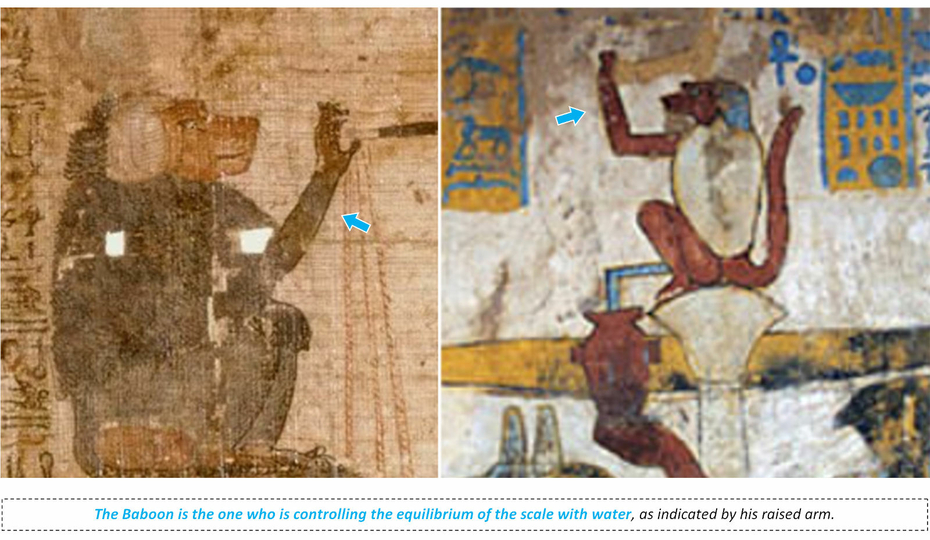
The peeing baboon is the key element of the Weighing of the Heart : he is the one controlling the equilibrium of the scale with his right arm, and he is doing it by (peeing) pouring water into the small jar at the equilibrium point of the scale.
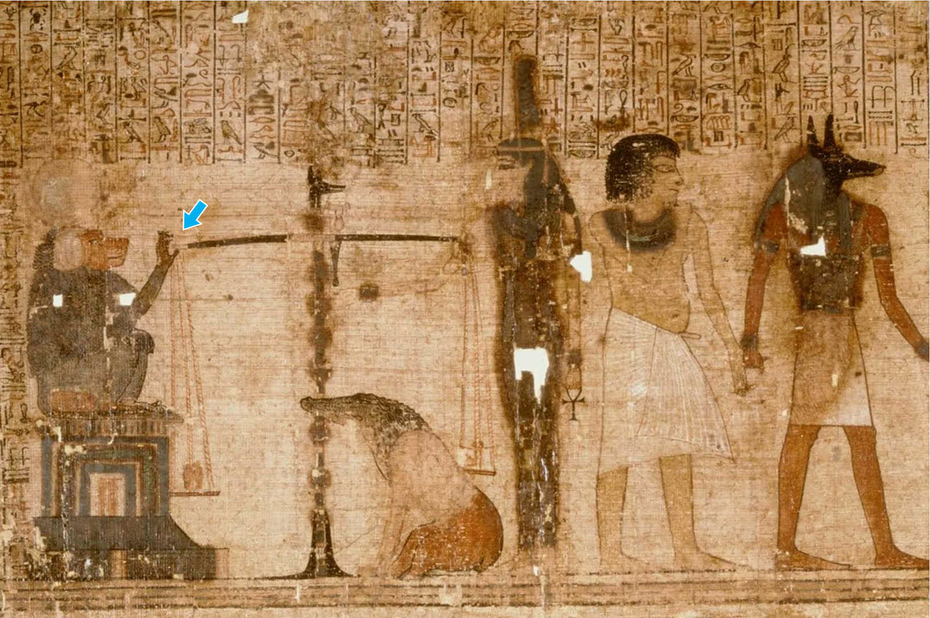
Weighing of the Heart judgment of the Dead in the Book of the Dead of 'merchant' Kenna. Papyrus in the Rijksmuseum van Oudheden in Leiden, Netherlands. Google Art Project : https://artsandculture.google.com/asset/book-of-the-dead-of-kenna-unknown/egEHQ9VZUYIVAg
20.04 The baboon is the key element of the Weighing of the Heart : he is the one controlling the equilibrium of the scale.
Baboons are the key element of the Weighing of the Heart representations, and nobody is ever talking about them even if they are present pretty much in every single one of them, most of the time standing on top of the scale's central post.
The baboon represented in the Weighing of the Heart of the Book of the Dead of Kenna (papyrus in the Rijksmuseum van Oudheden in Leiden, Netherlands), is unique, because it clearly shows the role of the Baboon in these scenes.
Look at how meticulous he is holding the horizontal beam of the scale : the Baboon is the one controlling the equilibrium of the scale.
But of course, Baboons are nothing less than metaphors, and they are about water.
We've already seen that snakes like Apep or Atum were water metaphors, but they were about pressurized water.
Here, the Baboons are just about plain water, as shown in so many water clocks : Baboon = Water
20.05 The extra layers on the original hidden meaning by ancient Egyptians themselves and 1800's egyptologists
Not only what is really depicted in the Weighing of the Heart artistic representations doesn't fit with the description made by egyptologists today, but I still didn't find any evidence of the act of having to physically weigh any heart in spell 125 : there is no such thing.
The Weighing of the Heart story that is made today only comes from false interpretation of the drawings, paints and reliefs that are representing the weighing scenes.
The thing is that it doesn't even really matter if Spell 125 describes the weighing of the heart or not. We've seen with the Dendera Light Bulbs that ancient Egyptians had perfectly represented the fog of microdroplets that created the cold, its oblong shape adjusting with the horizontal passage's own shape, but they also created a complete new myth about the creation of the universe as a disguise, that they could have presented to their people.
So, did ancient Egyptians themselves created the Weighing of the Heart story, another myth to present to people to explain the scale scientific and technological artistic representations or was it the first egyptologists in the early 1800's who came up with the story, I don't know. It looks like it is a "modern" thing, but it doesn't really matter, does it?
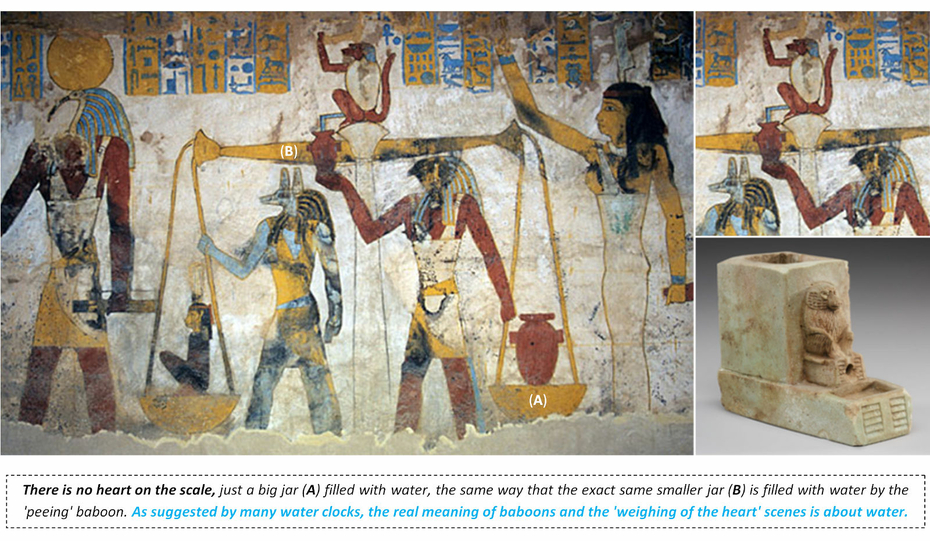
The Weighing of the Heart Justice scene ceremony in the sarcophagus chamber of the tomb of Baennentiu, Qarat Qasr Salim, el-Bahriya depression, Libyan desert, Egypt. Photograph courtesy of Roland Unger and posted on Wikipedia : "Justice scene: tomb owner Baennentiu conducted by Maat, Anubis and Horus with scales, Thoth, right wall in the sarcophagus chamber of the tomb of Baennentiu.
https://upload.wikimedia.org/wikipedia/commons/3/39/BawitiSelimBanentiuSanctRight.jpg
20.06 The peeing Baboon is controlling the equilibrium of the scale with water
The Weighing of the Heart Justice scene in the sarcophagus chamber of the tomb of Baennentiu is unique because it shows a baboon peeing into the jar that is connected to the equilibrium point of the scale.
This is to my knowledge the most explicit description of the real meaning of the small jar : it is a water jar. In no other draw or relief of the scene, is such a thing represented. The baboon is peeing into the jar!
We can probably assume that the peeing baboon in the tomb of Baennentiu is the same one, so to speak, that the baboon in the papyrus of the Judgment of the Dead of Kenna : both have the same raised controlling of the equilibrium of the scale arm.
One is controlling the equilibrium of the scale and the other one is peeing into the small jar.
We can assume that if they are the same baboon, then this is the peeing baboon who is controlling the equilibrium of the scale.
In other words, the small amount of water in the small jar is controlling the equilibrium of the scale.
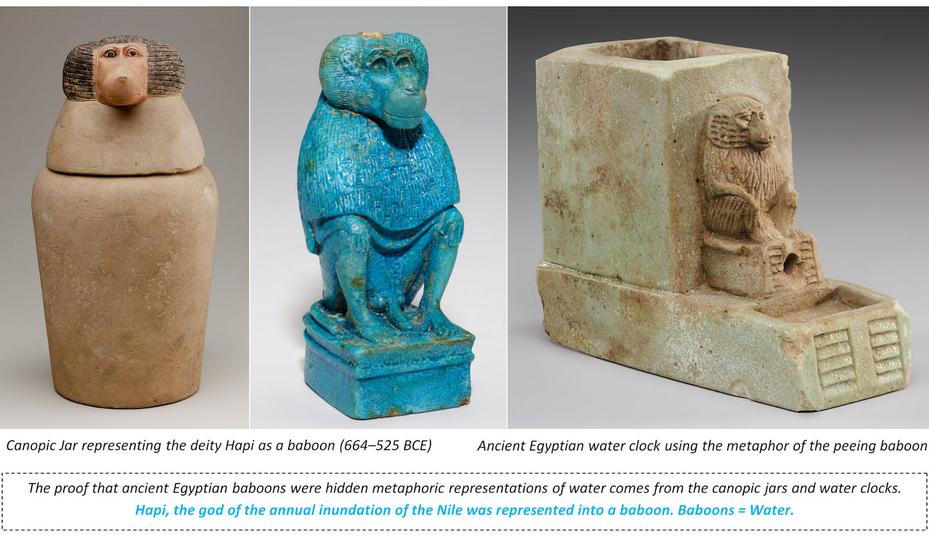
The idea that Baboons are another metaphor of water is also reinforced by the representations of the god of the annual inundation of the Nile on canopic jars : Hapi is depicted on these jars as a Baboon. In brief : Baboon = Hapi = Water from the Nile.
20.07 Ancient Egyptian baboons are all about water • 1 : the canopic jars of Hapi and the waterclocks
Canopic Jar Representing the Son of Horus Hapy, at the Metropolitan Museum of Art in New-York : https://www.metmuseum.org/art/collection/search/543953
All blue Baboon (Moon God Thoth) at the Minneapolis Institute of Art, 7th - 6th century BCE : https://collections.artsmia.org/art/126884/baboon-ancient-egyptian
Clepsydra or water clock with squatting baboon. Water within could drain from a hole between the baboons legs over a measured time. This object was likely a temple offering to the god Thoth in his role as overseer of knowledge and measurement." https://www.metmuseum.org/art/collection/search/572126
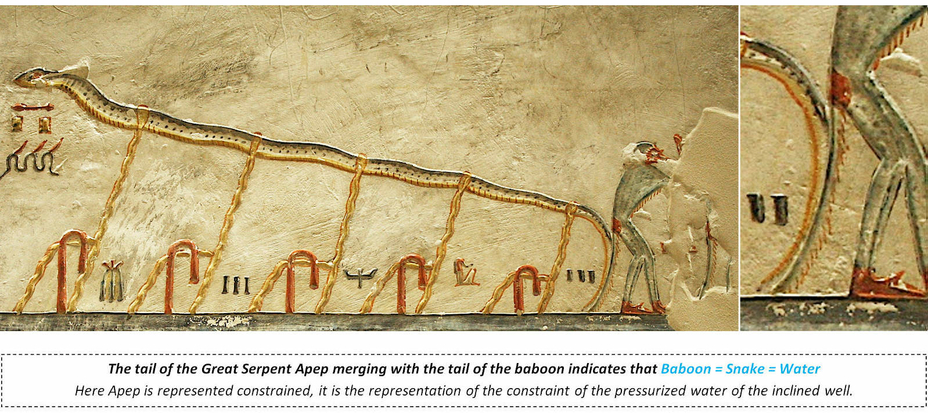
Apep, the Great Serpent Apophis, bound in Tomb KV9 in Egypt's Valley of the Kings, originally constructed for Pharaoh Ramesses V, 20th Dynasty: https://en.wikipedia.org/wiki/KV9
20.08 Ancient Egyptian baboon representations are all about water • 2 : the merging tail with Apep
The tail of the Great Serpent Apep merging with the tail of the baboon indicates that Baboon = Snake = Water
Here Apep is represented constrained, it is the representation of the constraint of the pressurized water of the inclined well.
More on the Great Serpent Apep, the metaphoric representation and glorification of the pressurized waters of the inclined well : Section 5
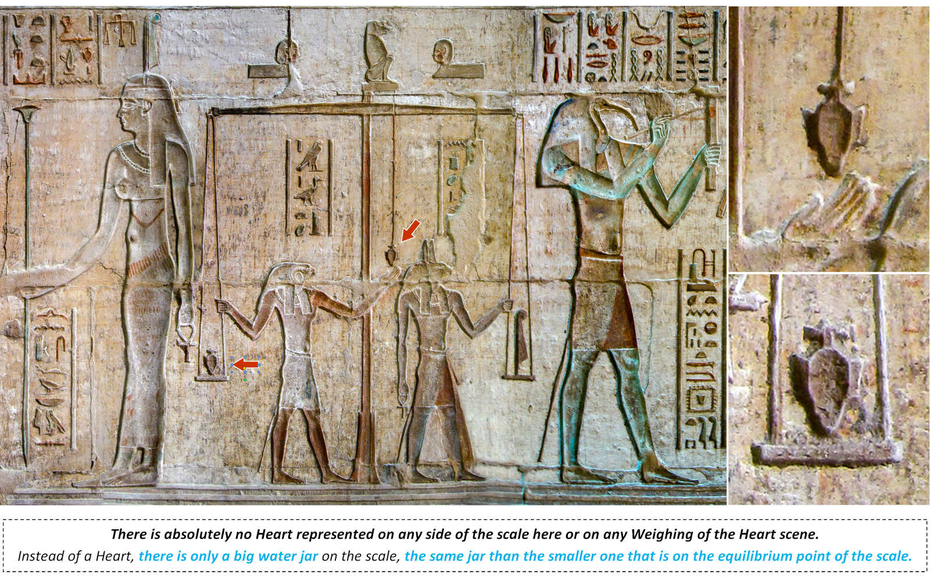
Weighing of the Heart relief at the temple of Deir el Medina, in the interior of the Hathor Temple of ''Deir el-Medina'' ("City Monastery"), ancient Egyptian ''Set Maat'' ("Place of Truth") , in Theben-West near Luxor, Egypt.
20.09 There is no heart anywhere on any side of any scale of the Weighing of the Heart
The Baboon and the Jars / No Heart • 1 : https://upload.wikimedia.org/wikipedia/commons/b/b1/Temple_of_Deir_el-Medina_Panorama.jpg
The Weighing of the Heart ceremony interpretations that we have today is the perfect example of the Romanticism influenced egyptologists of the early 1800's : there never is any heart on any scale in any Weighing of the Heart representations that we know of.
But because in numerous ancient Egyptian religious books, the Heart of the deceased person is so importantly discussed, firsts egyptologists came up with this so cute story about weighing the Heart of the deceased person.
Nowhere in these books is described such a cute Weighing of the Heart thing and nowhere in reliefs or art paintings showing the scale, is represented any Heart.
There is no heart anywhere, but in the dual Hapi representation : this is the only one occasion where we can see a Heart, and it is not a real heart, but what has become the Heart symbol.
We've seen that when ancient Egyptians talked about the heart, what they really had in mind was the Heart of the Great Pyramid.
They only compared their heart to the one of the Great Pyramid : the inclined well.
Their heart had to be as good as the inclined well.
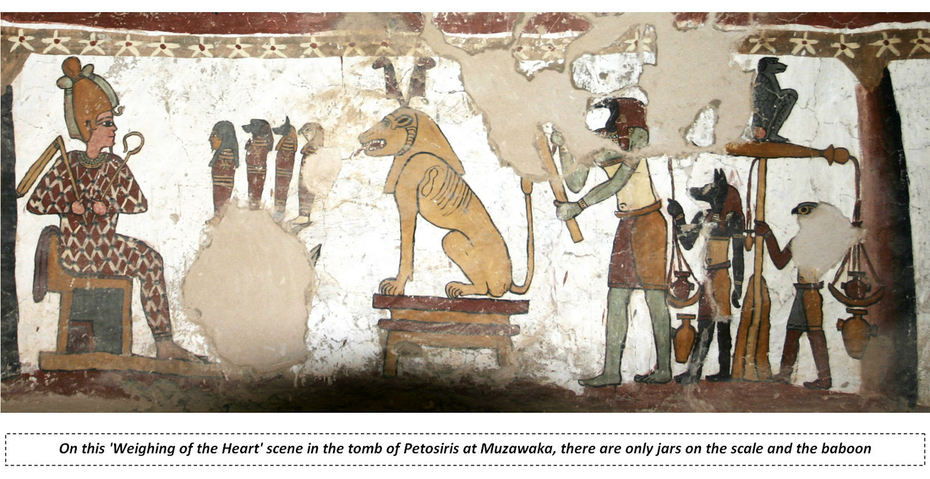
20.10 The Baboon and the Jars / No Heart • 2 : https://www.flickr.com/photos/isawnyu/4545650911
Paintings from the tomb of Petosiris at Muzawaka (XII) courtesey of the Institute for the Study of the Ancient World.
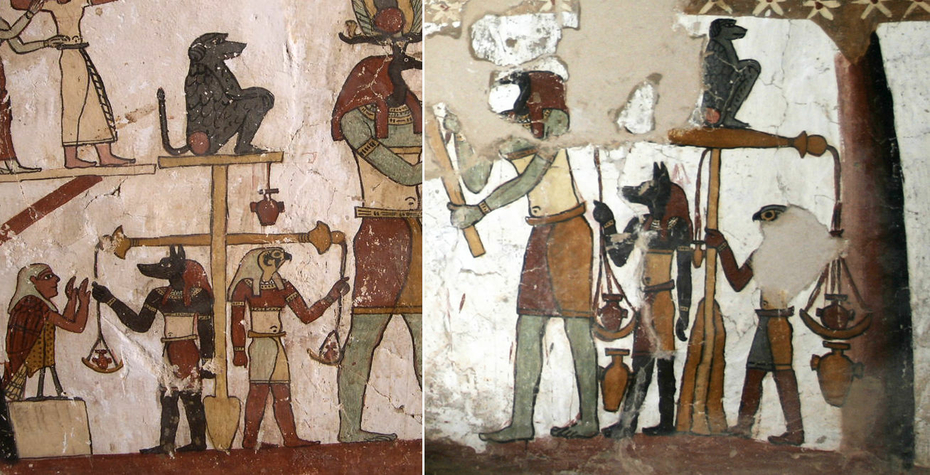
20.11 The Baboon and the Jars / No Heart • 3 : https://www.flickr.com/photos/isawnyu/4546290998
Paintings from the tomb of Petosiris at Muzawaka (XII) courtesey of the Institute for the Study of the Ancient World.
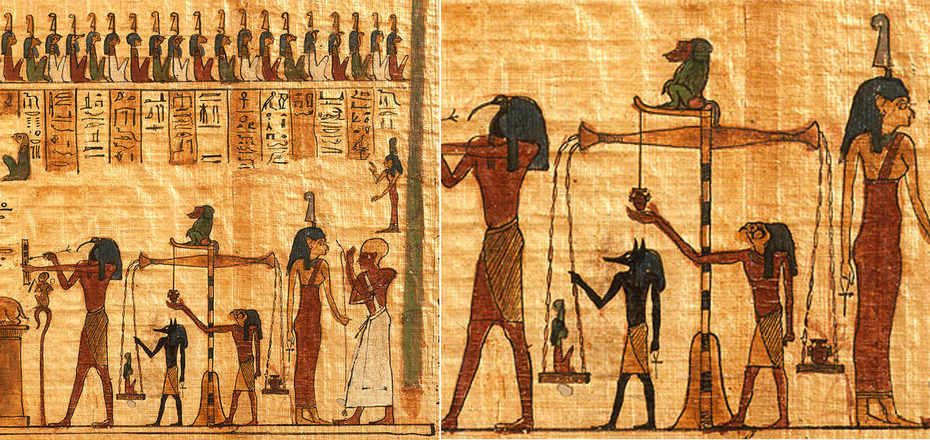
20.12 The Baboon and the Jars / No Heart • 4 : https://oi-idb.uchicago.edu/id/d5624b36-18dd-4724-94dd-583110080c57
Book of the Dead of Nesshutefnut (Papyrus Ryerson), Ptolemaic Period, ca 250 BCE at the Oriental Institute at the University of Chicago.
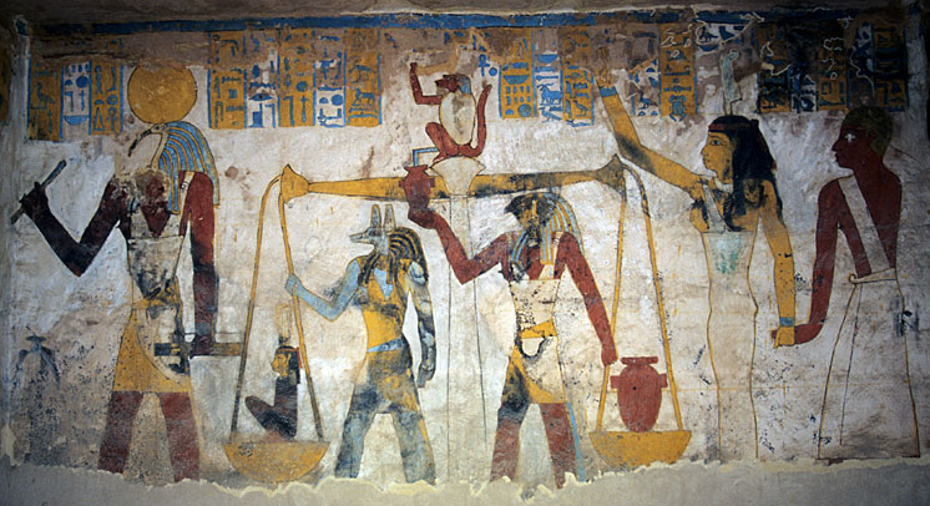
The Weighing of the Heart in the sarcophagus chamber of the tomb of Baennentiu, Qarat Qasr Salim, el-Bahriya depression, Libyan desert, Egypt. Photograph courtesy of Roland Unger and posted on Wikipedia : "Justice scene: tomb owner Baennentiu conducted by Maat, Anubis and Horus with scales, Thoth, right wall in the sarcophagus chamber of the tomb of Baennentiu.
20.13 The peeing Baboon and the Jars / Still No Heart • 5 : https://upload.wikimedia.org/wikipedia/commons/3/39/BawitiSelimBanentiuSanctRight.jpg
20.14 There are always only 2 water jars and a feather on the scale, without any heart
Not only there is no heart on any of the scales of the 'Weighing of the Heart' scenes, but there is one element that is always present but nobody is talking about it, and that is the baboon.
Most of the time the baboon looks like a simple 'decoration' in the scene and it is most probably the main reason he has been disregarded.
The problem is that in the Justice scene from the tomb of Baennentiu, the baboon is depicted peeing into a jar that looks like the equilibrium point of the entire scene.
If this small jar is filled with water, then the exact same jar, only bigger that is on the scale is also filled with water.
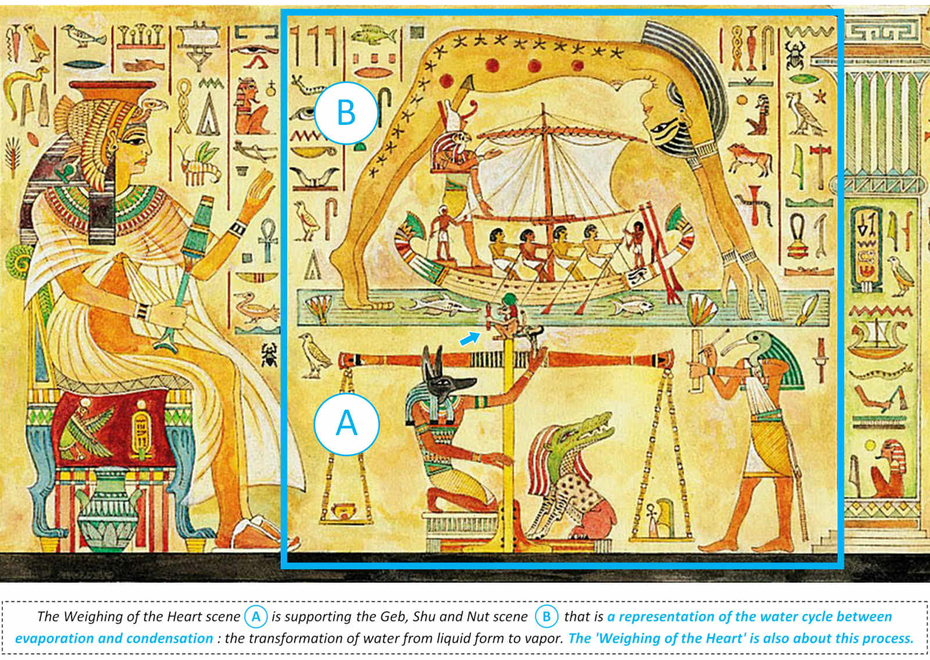
The Geb, Shu and Nut scene (B). On this particular representation, please note that Shu (the god of dry warm air) had been substituted with a sailing ship powered by the wind (the air) ; and that Geb had also been substituted with what he is really about too : liquid water. Geb is water in its liquid form.
The baboon is the representation of god of the Nile Hapi and here, he is set into that same water of the Nile.
20.15 The Baboon into the water is connecting the Weighing of the Heart (A) with the Geb, Shu and Nut scene (B)
We've seen in Section 3 that the representations showing Geb, Shu and Nut in very unusual positions, were metaphorical representations of the water cycle between liquid water and evaporated water; the cycle that is the core of the evaporative cooling process that was the very essence of the Great Pyramid functioning.
If the Weighing of the Heart scene in the above picture is positioned right under the Geb, Shu and Nut scene, and with the Baboon in the sea, part of both scenes, then it means that they are both connected.
20.16 The meaning of the Weighing of the Heart is given by the Geb, Shu and Nut scene context
The context of the Weighing of the Heart ceremony is crucial to understand it, and this context is given on the above image showing the Geb, Shu and Nut scene.
We've already seen that this context scene is describing the water cycle between liquid water and evaporated water, the evaporative process being supported by dry air. This is why god Shu is supporting Nut : dry air is supporting humidity, dry air is charging himself with humidity.
The Geb/Shu/Nut scene is actually one way of representing the evaporation and condensation processes : it is about the endless cycle of that transformation.
We'll see that the 'Weighing of the Heart' scene is the quantitative aspect counterpart of the Geb/Shu/Nut scene : it is about the quantitative aspect of water evaporation and condensation processes and the limitation of that process due to the initial humidity rate of the air.
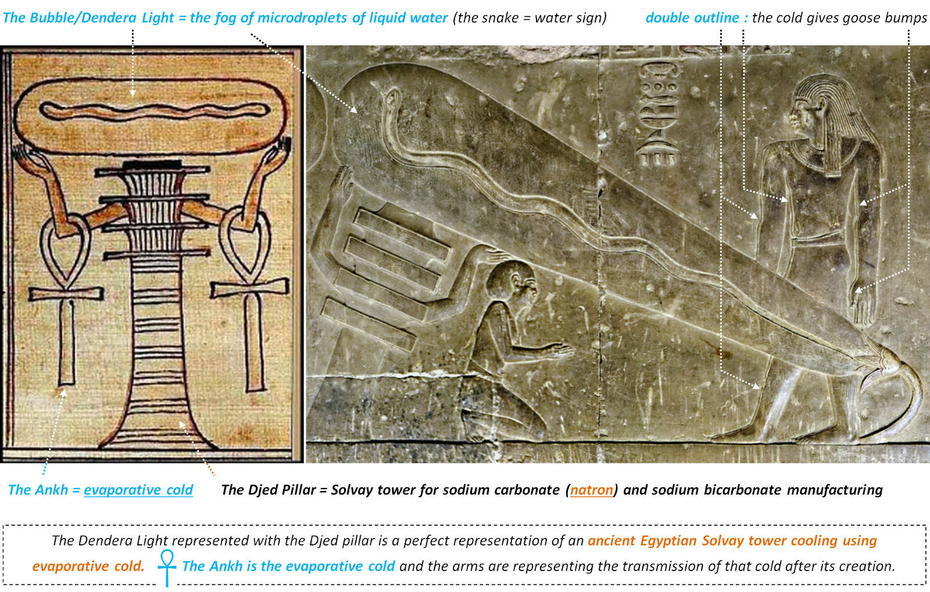
The "bubble" = the "Dendera Light" = the "egg" created by Atum and Thoth. Dendera Light, thanks to Kairoinfo4U on flickr : https://www.flickr.com/photos/manna4u/14525094039/in/photostream/
20.17 The creation of the egg by Thoth/Atum is the Dendera Light
"Thoth was the god of wisdom from Hermopolis in Middle Egypt. According to the Hermopolitan cosmology (which is best known from texts found at other sites), the eight primordial gods representing "hiddenness," "darkness," "formlessness" (?), and the "watery abyss" produced an egg that appeared at Hermopolis when the inundation subsided and from which the creator god appeared and brought everything else into being. When mentioned in the Heliopolitan Pyramid Texts, this creator god was Atum, but in the local Hermopolitan tradition he could have been Thoth."
Source : https://www.encyclopedia.com/philosophy-and-religion/ancient-religions/ancient-religion/thoth
This part about Thoth, who were often represented as a Baboon like Hapi, is very interesting because many things about how was created the evaporative cold.
It is mentioned eight primordial gods, and they are most probably referring to the eight crewmembers of the Hauling Beetle who were endlessly lifting up the impactor inside the Grand Gallery.
We've already seen that the "watery abyss" was referring to the waters of the inclined well, and the terms "hiddenness" and "darkness" could refer to both the Grand Gallery, the inclined well as well as the horizontal passage.
Then it is said that Atum and Thoth were born from an inundation and that they created from the watery abyss, an egg. That egg is the Dendera Light : the fog of microdroplets of liquid water that evaporated and created the cold.
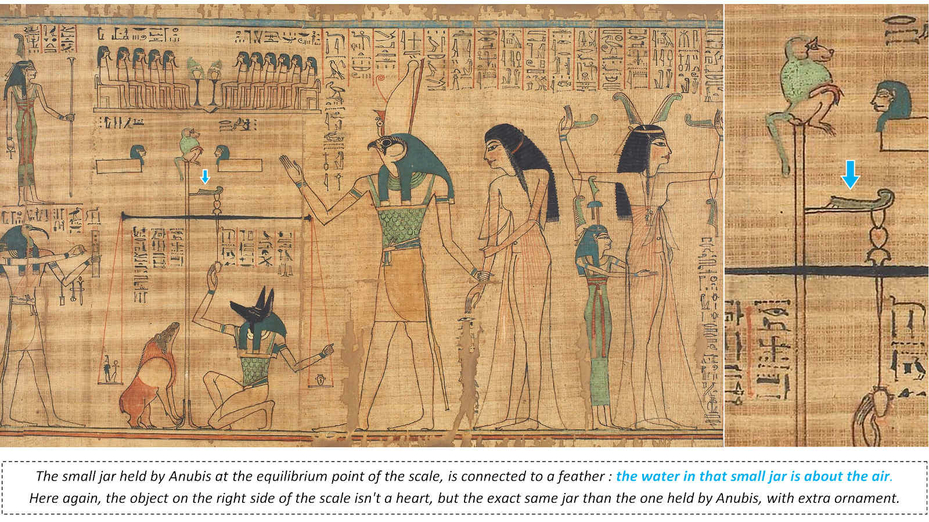
The little jar is suspended to a feather and so is about the air. Book of the Dead of Anhay, frame 4. © The Trustees of the British Museum. The judgment of Anhay : https://www.britishmuseum.org/collection/image/1613642214
20.18 The small water jar suspended into the air is the equilibrium point of the scale
The Judgment of Anhay is precious because it maybe is the only representation of the Weighing of the Heart where the true importance of the little jar is clearly depicted : it is not on the central vertical post that the equilibrium is marked, but on that little water jar held by Anubis.
20.19 The main limitation of the evaporative process : the small amount of water already suspended into the air
Today, we need to adjust engine settings to assure the most efficient performances of our motors; in the Great Pyramid, the efficiency of the horizontal cooling passage was only depending on the initial quantity of water that was in the air at the start of the evaporative process : the more humid is the air before you want to force water to evaporate, and the less cold it is gonna get.
In other words : the small amount of water that is already in the air before the cooling will change how much water you'll be able to force into that air.
That small amount of water in the air, the humidity rate of the air is determining the efficiency of the process : it is determining the equilibrium of the evaporative cooling.
That small amount of water already in the air, is the meaning of the small jar at the equilibrium point of the scale.
We know that for sure, because this small jar held by Osiris in the above image of the Book of the Dead of Anhay, is actually suspended from a feather, very similar (or identical) to the feather of Shu, the god of dry and warm air (Section 3).
The small jar suspended from the feather = the small amount of water 'suspended' into the air.
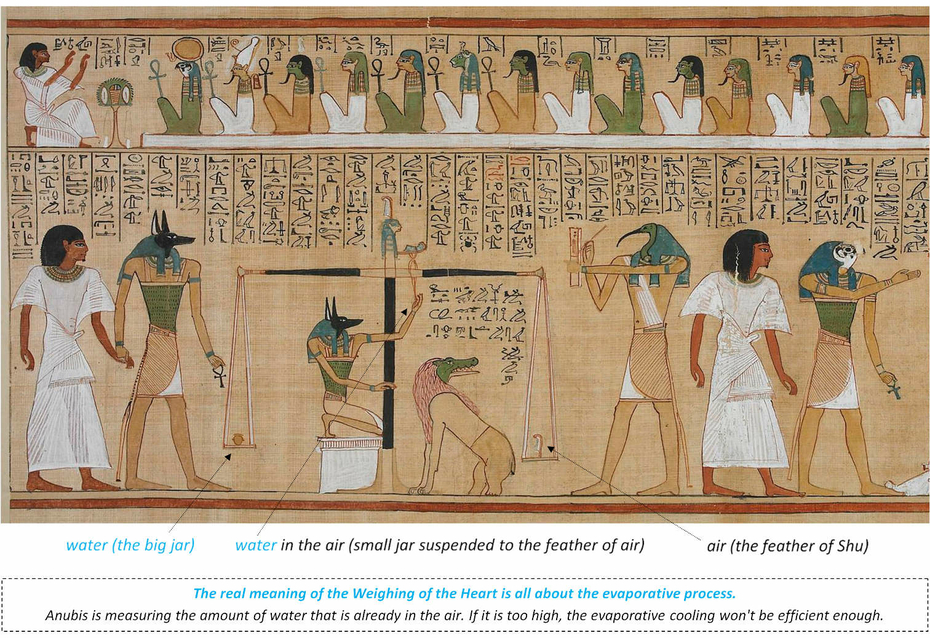
Book of the Dead of Hunefer (Hw-nfr) showing Hunefer's judgement at the British Museum, London : https://www.britishmuseum.org/collection/object/Y_EA9901-3
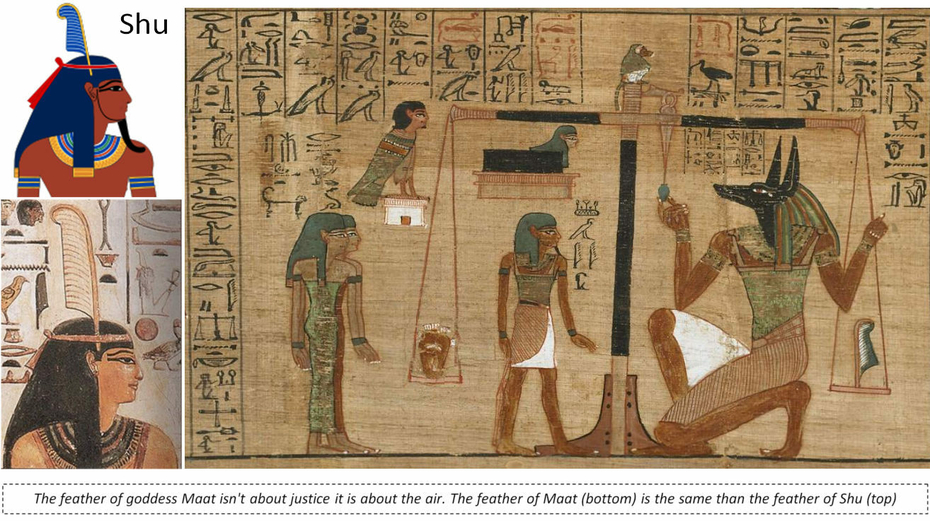
'Book of the Dead', Papyrus of Ani (frame 3): Ani's Judgment: the scene is the Hall of Judgment. EA10470,3 at the British Museum, in the Bloomsbury area of London : https://www.britishmuseum.org/collection/object/Y_EA10470-3
Maat wearing the "feather of truth" thanks to Lunazagor : https://commons.wikimedia.org/wiki/File:Maat.jpg
20.20 Maat is the result of the weighing process and can't be placed on one side of the scale
" Maat or Maʽat refers to the ancient Egyptian concepts of truth, balance, order, harmony, law, morality, and justice."
"After her role in creation and continuously preventing the universe from returning to chaos, her primary role in ancient Egyptian religion dealt with the Weighing of the Heart that took place in the Duat. Her feather was the measure that determined whether the souls (considered to reside in the heart) of the departed would reach the paradise of the afterlife successfully. In other versions, Maat was the feather as the personification of truth, justice, and harmony."
https://en.wikipedia.org/wiki/Maat
The fact that Maat's primary role dealt with the Weighing of the Heart ant that it took place in the Duat is very interesting. We've just seen that the Weighing of the Heart was all about the transformation of liquid water into evaporated water, and that the equilibrium of this process was determined by the small amount of water already present into the air in which the transformation occurred.
If Maat is all about this process, then Maat is the glorification of this equilibrium between evaporation and condensation and the process of evaporation into the air itself.
If the emblem of goddess Maat is the same one than the feather of god of the air Shu, it is because Maat is all about the air and how much water it can sustain, depending on how much water is already in that air.
The idea that pharaohs used their scientific and technological knowledge to legitimate themselves as kings of Egypt and that they had to perform successful demonstrations will probably irritate many people, however pretty much the same idea is developed with the concept of Maat :
"So revered was the concept of Maat that Egyptian kings would often pay tribute to gods, offering small statues of Maat, indicating that they were successfully upholding the universal order".
20.21 The Hall of Two Truths in the Underworld is the evaporative cooling passage
In short, we know that Maat dealt with the Weighing of the Heart in the Duat, the ancient Egyptian Underworld, and that she actually represented the equilibrium between both liquid and evaporated water : two different phases of water.
"In the Duat, the Egyptian underworld, the hearts of the dead were said to be weighed against her single "Feather of Maat", symbolically representing the concept of Maat, in the Hall of Two Truths". https://en.wikipedia.org/wiki/Maat
"The Hall of Two Truths" is the evaporative cooling passage where the two phases of water created the cold.
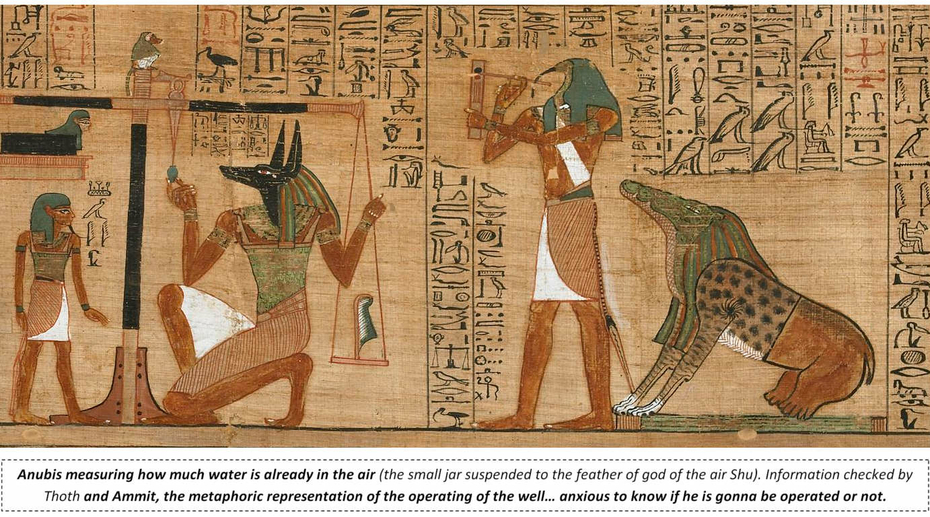
'Book of the Dead', Papyrus of Ani (sheet 3): Ani's Judgment: the scene is the Hall of Judgment. © The Trustees of the British Museum : https://www.britishmuseum.org/collection/object/Y_EA10470-3
20.22 Ammit is about the questioning of the interest of operating the well
Now that we know the real meaning of the Weighing of the Heart is about evaporation of water, there is something that needs to be pointed out : if the efficiency of the evaporative process is depending on the humidity rate of the air that is injected into the cooling passage, the small amount of water that is already in the air, then it means there is a point where there wouldn't be any interest to operate the inclined well : the cooling process wouldn't be efficient enough.
Ammit is all about that questioning : is it worth operating the well, depending on the humidity of the air.
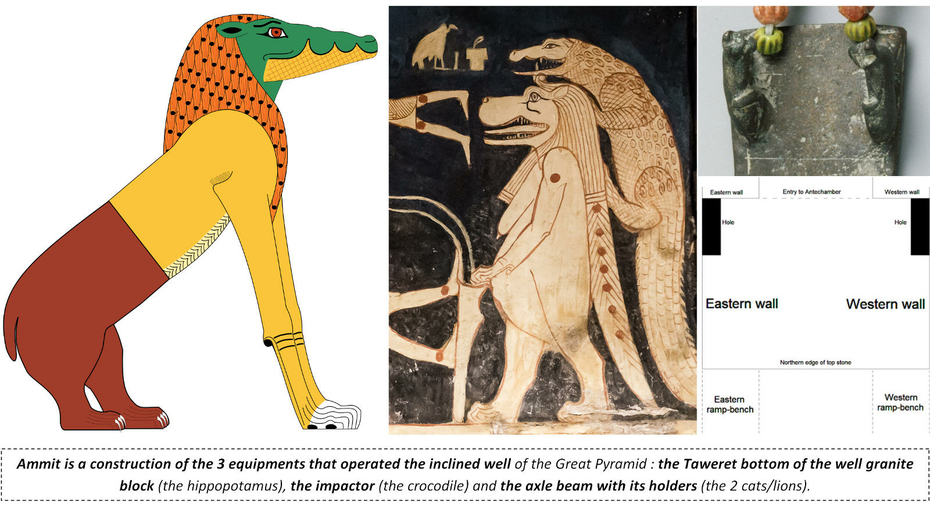
Draw of Ammit thanks to Jeff Dahl, on Wikipedia : https://en.wikipedia.org/wiki/Ammit
Image from the burial chamber KV17 of Seti I, thanks to kairoinfo4U : https://www.flickr.com/photos/manna4u/36500349182/
20.23 Ammit is the representation of the 3 equipments that operated the well : the Taweret block, the impactor and the axle beam
The first thing that struck me about Ammit, is that his lower part is an hippopotamus, and we've seen in Section 6 that Taweret was also represented into an hippopotamus and that she was a metaphoric glorification of the sealing block of the well, the upper granite plug #3.
So, the Taweret hippopotamus being the lower part of the inclined well and the lower part of Ammit being also an hippopotamus, then it doesn't take a genius to realize that Ammit could be representing the inclined well itself.
Actually, Ammit is much more than just the inclined well : the two other parts of his body isn't about the well, but about the impactor and the axle beam with its holders.
We've already seen in Section 8 "The draining of the well", that the crocodile in the Burial chamber relief of the tomb of Seti I, KV17 in the Valley of the Kings, was a representation of the impactor that pushed the Taweret block that was the sealing block at the bottom of the functioning well. The crocodile is one of the many representations of the impactor and he is here depicting the entire sequence of events that released the Taweret block from its initial position in the well and triggered its draining at the end of the operation period of the pyramid.
We've also already seen in Section 11 "The Hidden Hauling Cavern of the Underworld", that cat and lion representations were about Aker, and the equipment that was set onto the upper platform of the Grand Gallery of the pyramid : the axle beam and its holders that were set into the eastern and western holes of the platform.
It means that Ammit, part hippopotamus, part crocodile and part lion is a metaphorical construction of the entire equipment that operated the inclined well.
Of course here, the hauling gantry beetle isn't represented. The hauling beetle was the equipment that would come next, if it was worth operating in the first place.
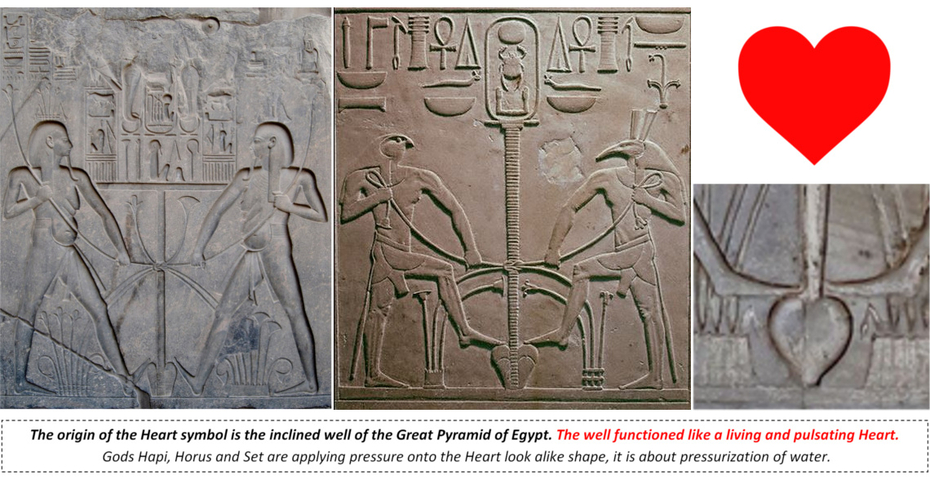
20.24 Was 42 the daily Heart rate of the Great Pyramid of Egypt?
We've already seen in previous Section 19 "The Churning of the Ocean Hindu myth" that when ancient Egyptians were talking about the Heart, they were referring to the heart of the Great Pyramid : the inclined well that functioned like a pulsating living heart.
In the crucial Spell 125 of the Egyptian Book of the Dead it is mentioned that the deceased person has to make a Negative Confession : "The Negative Confession (also known as The Declaration of Innocence) is a list of 42 sins which the soul of the deceased can honestly say it has never committed when it stands in judgment in the afterlife."
https://www.worldhistory.org/The_Negative_Confession/
Knowing that the whole Heart thing is about the inclined well, this number of 42 could be a very important data.
For some time know I evaluated the entire operating cycle duration of the Hauling beetle at something between 10 and 15 minutes, most of that time used to haul the impactor from its resting floating position in the well, up to the upper part of the Grand Gallery next to the top platform.
Let's say the entire team of the Grand Gallery was working 10 hours a day, from 8 am to 6 pm. With a 10 minutes cycle, it would have been possible for them to complete 60 cycles; and with a cycle of 15 minutes that number comes down to 40 cycles.
It means that working 10 hours a day, the Hauling beetle could have been able to complete 42 complete cycles of a little less of 15 minutes each, assuming the Beetle was never stopped being operated and that the crewmembers would have been regularly relayed.
In short, 42 cycles could have been the daily objective of the Hauling beetle crewmembers.
42 could have been the daily Heart rate of the Great Pyramid of Egypt.
20.25 The creation of the myths about the inclined well
It is very hard to imagine what really looked like the pyramid when operated, but certainly as I've already discussed many times in posts previous to 'The Pyramids of the Cold', the Great Pyramid wouldn't have been completed; it would have pretty much looked like the lower part of the Bent Pyramid, and if this Bent Pyramid is precisely in 2 parts, it must certainly has to be related to that lower Great Pyramid part for cold production.
But if the impactor hit the waters of the well every 15 minutes and if the Grand Gallery was somehow close to be in midair, the sound of the whole thing would have been heard probably kilometers away.
Everybody in ancient Giza would have been able to hear it, 10 hours a day, every 15 minutes for most probably a period of 4 months (Section 20). Residents of Giza would have heard it but also everybody coming to Giza from foreign countries : visitors, merchants, domestic and foreign dignitaries, etc.
Of course, the biggest impression would have been caused by the breaking of the Bes wedging block and the release of the Taweret block resulting in the tremendous shock with the Savior block (granite plug #2).
Everybody heard it, and everybody talked about it. This is how the inclined well inspired so many myths in the ancient World.
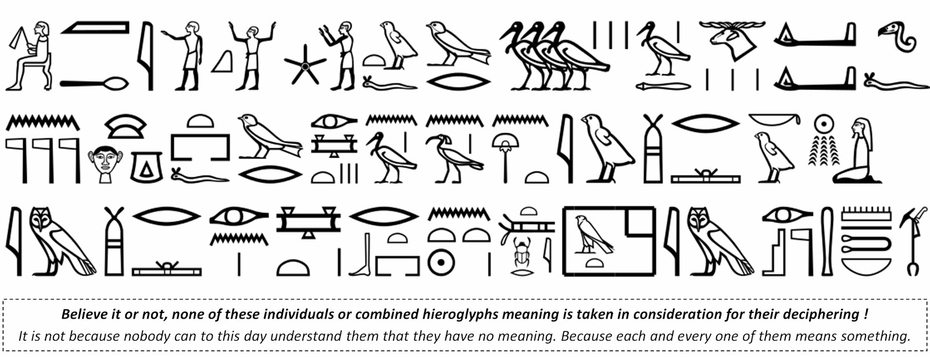
Hieroglyph signs thanks to Whynowagain : https://en.wikipedia.org/wiki/Lists_of_Egyptian_hieroglyphs#/media/File:CG_9422_B.svg
20.26 The truth about ancient hieroglyphs deciphering
Whoever is reading this, you certainly don't care, but I'm so pleased to have discovered how ancient Egyptians themselves called the evaporative cooling passage; because this passage was the start of my understanding of the Great Pyramid. Everything started in there, mid-January 2021, a year and a half and more than 2000 hours of hard work ago, with the vertical expansion joints and the fine sand lining behind the small blocks… the Hall of Two Truths ! Jesus, it's so beautiful !
The "Hall of Two Truths", or whatever the real original meaning is; because even if egyptologists are claiming that hieroglyphic text deciphering has been resolved, they are most probably wrong.
Not only the only thing that is resulting in their deciphering are consonants, egyptologists don't get any vowel ever; but more important : the meaning of the hieroglyphic sign isn't taken in consideration at all, they are only interested in the sound that every sign is associated to. Today, a typical hieroglyphic text deciphering looks like that (without any punctuation either) : hntrblkdfpmpbnrt.
Then, in between all these consonants, some vowels would be added here and there, partly depending on the mood of the moment (I'm only overstating a little about the mood, I guess).
The thing is that egyptologists don't care of the meaning of any of the about 1000 different hieroglyphs, and that is crazy : if it was only about sounds there wouldn't have been about 1000 signs created!
Each and every one of the hieroglyphs meaning has to be taken in consideration : when we'll understand the real meaning of every sign, then we'll be able to really decipher the hieroglyphs.
It also has to be pointed out that hieroglyphic language wasn't the only language ancient Egyptians could rely on : hieroglyphs are cryptographic signs, they were designed precisely to hide things that weren't supposed to be understood by the people. Only "priests" and the chosen ones could really have understood the language of the gods.
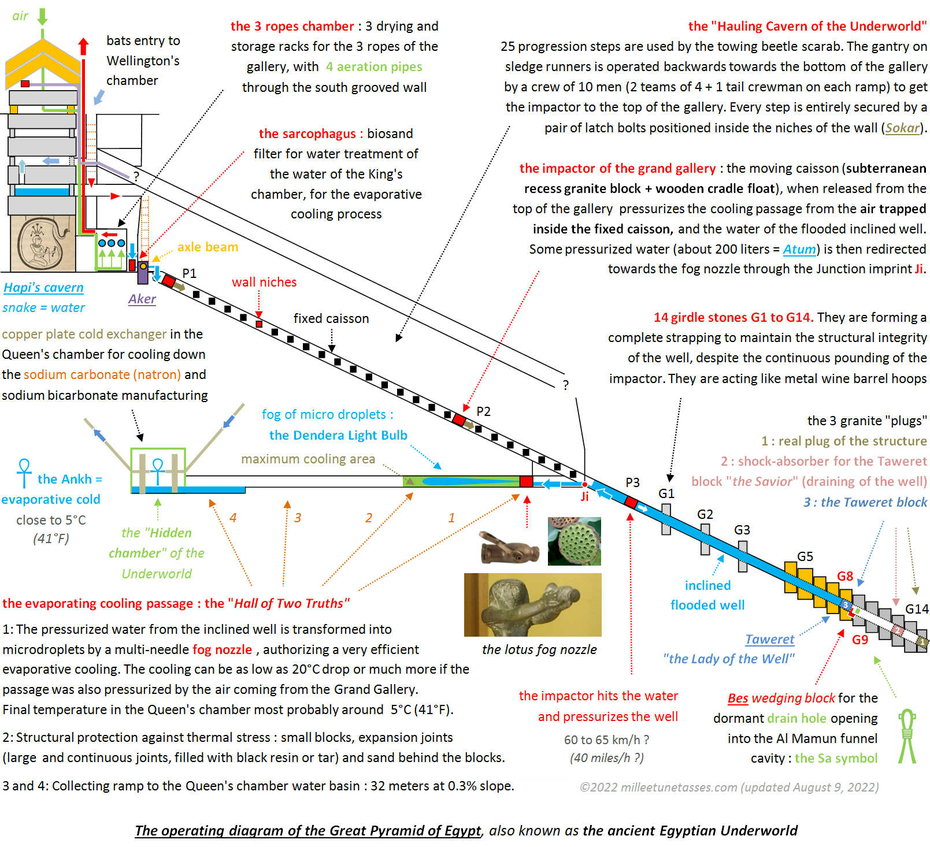
20.27 Operating diagram of the Great Pyramid of Giza in operation : its internal layout is the ancient Egyptian Underworld
Updated August 7, 2022 with a better representation of the bottom of the inclined well (the empty space between the real granite plug block #1 and the Taweret sealing block of the well, granite block #3) and the lower face to face girdle stones section.
Also added : the "Underworld Hall of Two Truths" as the evaporative cooling passage, where water in liquid phase evaporated itself to transform into vapor phase and the Hidden chamber as the Queen's chamber.
It is only for the shutdown procedure of the pyramid and the draining of the well, that the Taweret block had been released by applying more water pressure in the well, resulting in the breaking of the fragile and thin upper part of the Bes wedging block. Only then could the waters of the well have escape from it through the dormant draining hole into the Al-Mamun cavity which collected and redirected the water towards the subterranean chamber.
'Ji' is the Junction imprint that is connecting the pressurized waters of the inclined well to the evaporative cooling passage.
20.28 The internal layout of the Great Pyramid = the ancient Egyptian Underworld
The King's chamber = Hapi's cavern in the Philae temple, creating the very first snake (snake = water)
The Grand Gallery = the "Secret Hauling Cavern"
The Ascending Passage = the inclined well, home of the Great Serpent Apep (the pressurized waters of the well)
The Horizontal Passage = the "Hall of Two Truths" (the evaporative cooling passage filled with two phases of water, liquid and vapor)
The Queen's Chamber = the "Hidden Chamber" of the Underworld
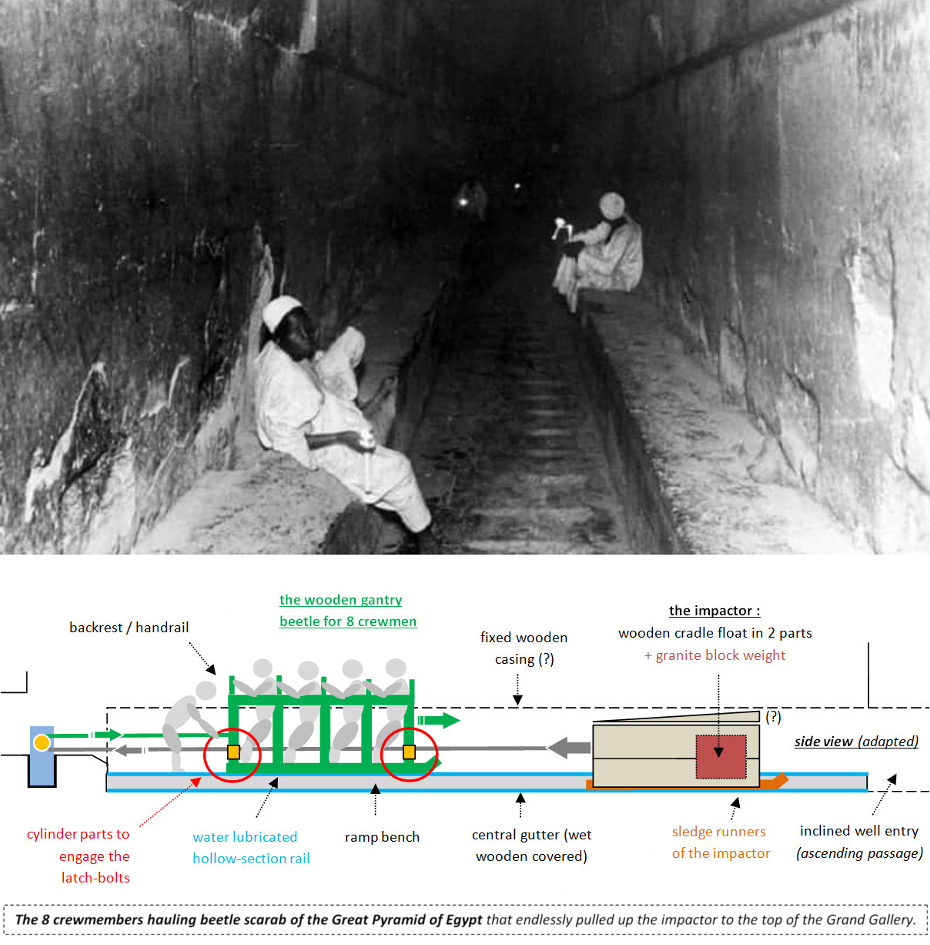
Section 11 • The Grand Gallery : the Hidden Hauling Cavern of the Underworld
20.29 Summary of the study : hidden behind the academic vision of the ancient Egyptian religion, a vast number of metaphors are describing some of the most advanced science and technological knowledge of that time : ancient Egyptian gods were nothing else than pharaohs' metaphoric self-glorifications of their theoretical and experimental scientific accomplishments in physics and chemistry.
Pharaohs used the power of Science to legitimate themselves as kings of Egypt : they forged an entire religion, based on science to rule their kingdom, and they presented that science as Magic.
The end game of this technological program that probably started on the very first Dynasty, was the Great Pyramid of Giza where evaporative cooling was engineered in the known part of the pyramid from the pressurized water produced in the inclined well, known today as the ascending passage.
The evaporative cold simply took advantage of the power of water, and was most probably necessary to cool down chemical manufacturing of sodium carbonate and sodium bicarbonate produced by an ammonia-soda Solvay process, as suggested by the very strong ammonia smell and the limestone kiln in the so-called burial chamber of the Red Pyramid. At that time, sodium carbonate was called natron, and it was the salt used for the mummification of the pharaohs (Sections 14, 15 and 16).
The cooling seems to have represented the most difficult part of the process, as suggested by the Step Pyramid's official name : according to scholars, the very first pyramid complex, the Step Pyramid of Djoser, was called "the refreshment of the Gods". No doubt that a more accurate translation would certainly be "the cooling of the Gods".
It means that ancient Egyptians were the first civilization to master a Solvay-like process for sodium carbonate manufacturing, long before it got reinvented in the 1800's in Europe. The key elements of that process is the temperature control of the chemical reactions (the cooling), and the dome shaped plate necessary for the counterflow chemical reactions to occur in an efficient way. That counterflow reaction plate is what really is the disc of Sabu.
As shown with Akhenaten and Nefertiti, the creation of the evaporative cold was the most sacred accomplishment of all (Section 17), and this is exactly what the Dendera Light is all about : the Dendera Light is the fog of microdroplets of liquid water that evaporates and creates the cold. Talking about the snake inside the Dendera Light Bulb : "The field surrounding Ra’s snake form is referred to in ancient Egyptian literature as protective magical energy in liquid form that all gods and pharaohs possess" (Faulkner, Section 2).
Everything that had been done in the Great Pyramid of Giza inspired most of the ancient Egyptian religion, and it had been glorified into what we know today as the Underworld.
The Underworld is referring to the chambers and passages of the Great Pyramid of Khufu, and in particular to the Grand Gallery where a hauling gantry beetle operated a wooden coffin shaped impactor that had a small nested granite block inside it. The impactor generated endlessly, over and over, maybe every 15 minutes the pressurized water that was then transformed into a fog of microdroplets inside the horizontal cooling passage.
The Grand Gallery of the Great Pyramid where the act of hauling was done, is the "Secret Hauling Cavern of the Underworld" described in the Amduat "Book of the Hidden Chamber".
The most important chamber of the Great Pyramid wasn't the King's chamber that only was the main water tank of the pyramid, but the Queen's chamber, the only one on the central axis of the pyramid. Because the Queen's chamber was inaccessible from the rest of the pyramid, it was glorified into the "Hidden Chamber of the Underworld" (Section 11), and because the Queen's chamber was the coolest place in the pyramid (about 5°C / 41°F), and with a constant 100% Humidity rate, this chamber was the one where the biggest amount of very hard salt encrustation had been documented by the first explorers of the pyramid in the 1800's and before it had been removed in 1998 by Zahi Hawass (Section 1). Very hard salt encrustation is the signature of the evaporative cooling process, even nowadays.
The most incredible thing is that pretty much everything I've just said, actually appears in one single myth, but it doesn't originate from ancient Egypt : it is the "Churning of the Ocean" Hindu myth that produces the immortal nectar Amrita. The fact is that the endless churning of water that ends up with the production of an elixir that gives eternal life, is exactly what were doing ancient Egyptians in the inclined well : natron was the salt used for the mummification of pharaohs.
Natron gave eternal life to pharaohs, just like the Amrita (Section 19).
Poster un commentaire

